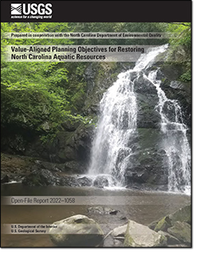Value-Aligned Planning Objectives for Restoring North Carolina Aquatic Resources
Links
- Document: Report (1.44 MB pdf) , XML
- Download citation as: RIS | Dublin Core
Abstract
Rapid population growth and development in the southeastern United States have resulted in substantial impairment to freshwater aquatic ecosystems. National or regional restoration policies strive to address impaired ecosystems but can suffer from inconsistent and opaque processes. The Clean Water Act, for example, establishes reallocation mechanisms to transfer ecosystem services from sites of disturbance to compensation sites to offset aquatic resource functions that are unavoidably lost through land development. However, planning for the prioritization of compensatory mitigation areas is often hampered by unstructured decision-making processes that are narrowly framed because they are not co-produced with stakeholders affected by, or having an interest in, the impacts and mitigation. This summary report represents the collaborative efforts of the U.S. Geological Survey and the North Carolina Department of Environmental Quality, Division of Mitigation Services, to co-develop an applied decision framework following the principles of structured decision-making for prioritizing watershed catchments by their potential for realizing a range of beneficial outcomes from future mitigation projects. The framework focuses on supporting the State’s nationally recognized stream and wetlands compensatory mitigation program by clarifying a discrete decision problem and specifying agency and stakeholder values to formulate fundamental and means objectives for prioritizing restoration sites. The co-development of this decision framework resulted in a number of useful insights from the perspective of the decision maker, including recognition (1) that the problem is a multi-objective decision driven by values beyond restoring lost functionality of ecosystems (that is, biogeophysical goals), (2) that the decision comprises a linked and sequential planning-to-implementation process, and (3) that future risk associated with land-use and climate change must be considered. The outcomes of this collaboration can serve as a systematic and transparent framework to prioritize a wide range of restoration, conservation, and resource-allocation activities in similar environmental contexts across the Nation.
Suggested Citation
García, A.M., Eaton, M., Sanchez, G.M., Keisman, J.L., Ullman, K., and Blackwell, J., 2023, Value-aligned planning objectives for restoring North Carolina aquatic resources: U.S. Geological Survey Open-File Report 2022–1058, 20 p., https://doi.org/10.3133/ofr20221058.
ISSN: 2331-1258 (online)
Study Area
Table of Contents
- Acknowledgments
- Abstract
- Introduction
- Applying Structured Decision Making
- Decision Problem
- Fundamental Objectives
- Component Objectives and Measurable Attributes
- Objectives Framework for the Division of Mitigation Services
- Objective 1—Maximize the Feasibility of Mitigation Projects
- Objective 2—Maximize Aquatic Resources Health
- Objective 3—Minimize Future Risk of Impairment
- Potential Future Enhancements
- References Cited
| Publication type | Report |
|---|---|
| Publication Subtype | USGS Numbered Series |
| Title | Value-aligned planning objectives for restoring North Carolina aquatic resources |
| Series title | Open-File Report |
| Series number | 2022-1058 |
| DOI | 10.3133/ofr20221058 |
| Publication Date | April 11, 2023 |
| Year Published | 2023 |
| Language | English |
| Publisher | U.S. Geological Survey |
| Publisher location | Reston, VA |
| Contributing office(s) | South Atlantic Water Science Center |
| Description | vi, 20 p. |
| Country | United States |
| State | North Carolina |
| Online Only (Y/N) | Y |
| Additional Online Files (Y/N) | N |


